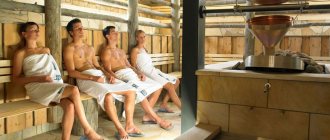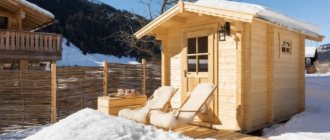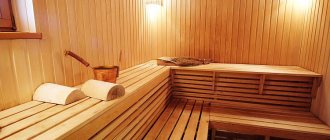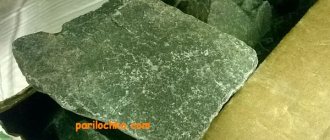The traditional material for building a bathhouse is wood. And this is no coincidence; the benefits of bath procedures are most fully manifested in a log steam room, in which a special microclimate is created, filled with the healing aromas of natural wood. But on the other hand, high humidity and extreme temperatures characteristic of a steam room do not have the best effect on wood, which quickly deteriorates in such conditions. Treating the bath with oil will help prevent destructive processes. In this regard, in the article we will focus on two main points: what are the best oils and impregnations to use in a steam room, as well as how to properly treat the internal surfaces of a bath with oil compositions.
What to cover with? And is processing necessary?
Let's start with a tricky question. The fact is that many bathhouse owners believe that the shelves in the bathhouse do not need to be treated with anything . At the same time, they easily accept the fact that wood, under the influence of heat and steam (humidity), quickly becomes dark and then collapses. It is believed that it remains environmentally friendly and this is more than enough, because the main thing is human health.
It is simply impossible not to agree with the last argument, but no one contrasts the beauty of the steam room with the health of its visitors .
Now, if there was such an impregnation for shelves in a bathhouse, which at the same time was completely harmless to our bodies and increased the durability of the tree - who would refuse it? IMPORTANT! Treatment of shelves in a bathhouse is not necessary only if its use raises concerns for human health.
Below we will consider in detail the compositions of various impregnations and their effects on humans. For now, let’s summarize briefly, naming the pros and cons of both choices.
Processing: pros and cons with and without it
Pros without processing:
- no chemicals evaporate at elevated temperatures and humidity from the surface of such a tree;
- the processes occurring with wood in the steam room are completely natural;
- the smells are only natural, which is especially pleasant when aromatic species are used - linden, for example, or cedar.
Cons without processing
- wood swells under the influence of moisture and contracts when dried, while its dimensions change and cracks may occur;
- it darkens;
- the shelves are exposed not only to heat and steam, but they are also exposed to human sweat (a caustic mixture of salts) and fat, which are absorbed into the wood, creating a characteristic smell in the steam room, by the way;
- with more or less ease (depending on the species), the tree succumbs to rot (mainly fungi) and collapses.
Linseed oil
If you are still firmly convinced of the need to treat the interior of the bathhouse with additional compounds, try to use them in a minimal amount in the steam room. The most common and safest way to treat steam room wood is to coat it with one or two layers of technical linseed oil. This oil can be purchased at pharmacies, grocery stores, or specialty hardware stores. An analogue of linseed oil is simple drying oil, which is made from linseed oil and special polymerization catalysts (accelerators) (the process of hardening the surface layer of drying oil).
The only danger when buying drying oil is the possibility of falling into the hands of an unscrupulous manufacturer who made his drying oil not from linseed oil, but from some other oil. Therefore, if you still decide to cover wood in a steam room, it is best to take pure linseed oil, the quality of which you will be sure of.
Although flaxseed oil is safe from the point of view of chemical emissions in a steam room operating at high temperatures, it nevertheless also has its own characteristics. If you apply too much of this oil to wood in a steam room, then when it is heated, there will be a strong smell of oil inside the room. Getting rid of this smell will not be easy: you will need to use the sauna at full capacity more than a dozen times until the smell goes away completely.
Flaxseed oil also comes in solid form. To harden, pine resin, gum turpentine and an antiseptic based on zinc are added to it. Its use in the steam room is prohibited, but treating furniture, walls or floors in the washing room and other areas of the bathhouse is completely acceptable.
Impregnation: the difference between a bathhouse and a sauna
We would call this question archivally important. Because it is the temperature that determines the evaporation of substances that impregnate the top layer of wood.
ON A NOTE! If it is small, then even the toxic(!) substances with which we cover the tree remain harmless to humans, hiding under the protective layers of other compounds.
And it is precisely the temperature that distinguishes a Russian bathhouse from a Finnish one . Therefore, let's agree that the compositions that we consider absolutely suitable for a Russian bath with its temperature not exceeding 60 degrees during the entire steaming period should not be recommended to sauna owners, where the temperature sometimes rises not only to the recommended 90, but also to 100-110 degrees (we simply do not consider higher).
The second, less important parameter is humidity. In a sauna it is low (5-15%), in a Russian sauna it is high (50%). In principle, a less humid sauna spoils the wood less, so you can actually do without impregnation at all, but the Finns rule here, and they believe that impregnation should be done at least for beauty and cleanliness.
The humidity of a Russian bath should be considered an argument in favor of water-repellent impregnations.
Coatings for different types of surfaces
Here we have already mentioned that the temperature regime of the steam room is not uniform; there are places with more and less high temperatures. It is logical that when the furnace is operating, the areas next to it and under the ceiling will be the hottest, because heated air is lighter than cold air and tends upward.
Therefore, floor coverings differ from ceiling and wall coverings. Due to the fact that much has already been said above, we will briefly go over all types of steam room surfaces in a bathhouse and how to treat them.
How to treat walls
You can learn about what and how to cover a steam room from this article. Here we will say that there are only two options - it is either a solid log/timber or lining. In both cases, we are talking about natural wood, so all compositions are focused specifically on it.
How to paint a log house in a steam room
You already know the first option - do not paint with anything. But if for some reason this option is not suitable for you, then you can cover the steam room in a bathhouse made of timber or logs with either wood impregnation acrylic varnish.
In principle, the wood will not darken and will dry out less when treated with conventional impregnation, but you will have to spend quite a lot of it. You can calculate the quantity by asking the sellers about the number of layers and impregnation consumption per square meter.
Water-based varnishes will also protect wood, and they are more decorative due to additives - color or... mother-of-pearl. Yes, that’s right - we came across Tikkurilov’s acrylate varnish “Supi Arctic” with the addition of mother-of-pearl. This was probably supposed to symbolize, in contrast, the flickering of snow in a hot steam room.
Color schemes, as already mentioned, have long ceased to replicate only the yellow and brown colors of different types of wood, but most of us are conservative and do not want to see turquoise-colored wood.
How to treat lining in a steam room
The lining in the steam room of the bath should be treated with the same compounds that you would use if you had a bathhouse made of logs.
Useful video
We have a detailed article on how to treat lining in a bathhouse. You can watch the link or watch the video version below.
Floor treatment
If you have a ceramic tile , then it does not need additional treatment. But if it is made of wood, then it would still be worth protecting it from moisture. Here, too, you can choose to use either impregnations or aqualacs.
Above we talked about the permissibility of using yacht varnish - this type is designed to cover wooden boats and yachts that remain in water for a long time, so periodic spills of water on the floor are not dangerous for such varnish.
If you are still worried about the release of volatile organics, measure the floor temperature yourself while vaping. If it does not exceed 30 degrees, there is nothing to worry about.
The main difference between floor coverings is that they take into account the fact that we walk on them, and friction leads to abrasion. Therefore they must be more durable. However, nothing prevents you from purchasing a composition without strength-increasing additives. It will just have to be renewed from time to time.
Ceiling treatment
Despite the fact that the ceiling is the hottest part of the steam room (not counting the space next to the stove), the coverings for it are usually the same as for the walls. Of course, they must be specialized specifically for the steam room.
How to paint the shelves
You will find detailed material on how to paint the shelves of a steam room in a bathhouse on this page.
Here we will say that varnishes and paints are not suitable for shelves, because they are in contact with the human body and their thermal conductivity is different from wood, so a layer of varnish or paint could burn the skin.
The only available option is impregnation. They will prevent the shelves from darkening and smelling of sweat. And at the same time, they will increase their durability, because the shelves are usually made of linden or aspen, whose wood is soft and not resistant to rotting and infection.
How to cover windows and doors
Windows and doors are also most often made of wood. The exception is glass sauna doors, made of solid heat-resistant fabric. However, they also have wooden boxes.
In any case, the same compositions should be used to cover the doors as for the walls of the steam room. At least from the inside. From the outside (if necessary), you can use any composition that will match the overall design of the room. Read more here.
As for windows, their very presence in the steam room is a controversial issue. But if they are made, then they are thick, with several glasses. The outer part facing the street is exposed to precipitation, so it can be protected with the same yacht varnish (if it is not made of PVC on the outside). The interior can be coated with either acrylic varnish or impregnation.
What to soak: varieties and their purpose
You come to the store to choose a wood impregnation, and there are so many options there that your eyes widen.
In reality, you just need to distinguish between goals. A bathhouse is most often a separate building, in which, in addition to the steam room, there are other rooms . Many baths are built of wood or have wooden lining. There is wooden furniture everywhere. All this implies different purposes and compositions for them. Manufacturers of protective impregnations distinguish them as follows:
- What does the composition protect against: from water, from infection by fungi, from insects, from rodents, from fire;
- the composition is based on oil or water;
- what exactly is intended to protect: furniture, walls, floor, ceiling;
- product release form: gel, solution, aerosol;
- The wood will retain its natural color (bleach is a separate type) or will be tinted. In the latter case, a catalog of shades is offered.
In our particular case, we are looking for something to saturate the shelves in the bathhouse with. Now let’s decide on the task: what we want to protect the shelves from. It’s tempting to protect against everything at once, but without going into details for now, let’s say that antiseptics and fire retardants do not have a beneficial effect on our health, that is, it’s not worth protecting shelves from rot and fire .
Basically, the wood of the shelves is protected from water . In addition, not only for the sake of beauty, but also as a type of antiseptic , bleaches are used which return darkening wood to its original color.
We will now consider this limited set of what can be used to cover the shelves in a bathhouse.
Impregnations, colorless and colored
Everything here is quite simple: if you add one or another color to the impregnation, which has no or little effect on the original color of the wooden surface, then the result will be a colored impregnation . Wood painted with it will differ from wood coated with regular paint in that its texture will still be visible .
Each manufacturer of color impregnations accompanies its products with a catalog of colors, from which it is easy to choose the right one. Colors for impregnation are not sold separately.
ON A NOTE! Colored colors can be included in both water- and oil-based impregnations.
Oil
The most well-known property of oils and waxes is their hydrophobicity, that is, non-wetting by water. This is precisely what predetermined their use in the creation of water-repellent compounds for wood.
However, there is one important point: in the simplest case, a hydrophobic coating forms a film on the surface of an object, which differs in its thermal conductivity from wood. In practice, this means that the coating can burn if the air in the steam room is heated to a high temperature.
Therefore, manufacturers contrive to prepare oil for shelves in a bathhouse in such a way that the impregnation is absorbed into the wood without creating a noticeable film on the surface.
Usually bath oil has no color, but there are tinted ones too.
Bleaches
Experienced steamers are not deceived when they see light wood in the steam room - it won’t stay that way for long if you use the bathhouse regularly. However, their expectations may not be met if the owner of the steam room uses special impregnations that bleach the wood.
IMPORTANT! Any bleach will contain either a substance containing chlorine or hydrogen peroxide.
Strong oxidizing agents not only lighten, but also disinfect wood, destroying fungi and their spores too..
The depth of penetration of the composition also depends on the concentration of the active substance. Bleach can be in a more or less concentrated form when sold, and then, if desired, it can still be diluted with water.
How to choose the right shelf oil
Processing the shelves is an important condition for maintaining a healthy atmosphere in the steam room. When choosing oil impregnations, it is important to pay attention to the composition. The beneficial active ingredient is flax. This natural antiseptic prevents rotting, the development of parasites and mold, and the formation of cracks. Synthetic resins are 50 times heavier than flax molecules and are not able to penetrate very deeply into the pores of wood.
Before deciding what to cover the shelves in the bathhouse or steam room with, it is important to consider that the oil must create a hydrophobic coating and maintain an aesthetic appearance. The durability of the wooden base is the main task that the chosen impregnation should fulfill. You can’t save money; it’s better to purchase proven and high-quality products.
Bathhouse shelves: how to treat them without causing harm to health?
Let's divide all impregnations into two conditional camps , in the first of which there is something that should not be used at all or with restrictions, in the second - the most safe.
Which ones are not recommended or can be used with limited use?
So we get to the important thing: how to distinguish between the harmfulness of a composition? First of all, let us agree to believe that what is harmful to lower forms of life will most likely be harmful to higher ones .
In any case, this rule works when it comes to antiseptics. Allowing the antiseptic to evaporate under the influence of high temperature and breathing it in, and sitting on the surface treated with it... is not the best solution. As for bleaches based on chlorine or hydrogen peroxide, the following should be taken into account: both are harmful to health, but both erode in a reasonable time. Peroxide generally decomposes into innocent water and oxygen. This happens even just in the light.
BY THE WAY! Have you already noted that bleach also works as an antiseptic?
You should absolutely not use anything from the list of exterior impregnations - this is something that cannot be used inside any room. But this is an obvious thing. But a variety of varnishes, including those that are actively promoted as suitable for use in baths and saunas...
Firstly, if you choose a varnish, then the one that is said to withstand the high temperature of the steam room. All the rest, if they are suitable for a bathhouse, are somewhere in its other rooms.
Secondly, varnish is not at all recommended for coating shelves . Perhaps someone will cover the window frame with it - both the area is small and the tree is protected.
ADVICE! Even when we see high-quality Finnish sauna varnishes on sale, we believe that they have no place there. A window frame in a steam room coated with varnish is normal. But everything else, including stones (yes, the Finns suggest varnishing stones) is not worth it.
In general, varnishes, antiseptics and fire retardants are not for the steam room !
Which ones are completely safe?
And yet I would like the wood in the steam room to last longer. And if it is not wetted with water, its preservation will increase. This means that we can recommend as completely safe those impregnations that repel water and do not form a film on the surface.
ADVICE! For better absorption after applying the composition, it is recommended to heat the oven. The excess is then simply removed with a cloth.
Actually, there are no other safe options - only some kind of oil wax or special oil for bathhouse shelves.
IMPORTANT! The difference between oils and oil waxes is the following: the depth of penetration of the composition and, as a consequence, the frequency of coating renewal. It is higher for oils from 0.5 to 2 years.
Design features
The most widely used shelves are those consisting of a seat and support posts. Racks (thick vertical beams) are installed across the entire width of the shelf and connected by jumpers. As a rule, there are only two racks.
The seat is made of thinner boards. They are nailed to the frame in such a way that there is a distance of at least 1 cm between them. To prevent water stagnation, the shelves should be made inclined. To do this, it is enough to maintain an angle of about 2°. The width and thickness of all nailed boards must be the same. The required strength of the structure being constructed can be ensured if the thickness of the board is four times its width.
The shelves must be 1.5 meters or more in length. The optimal length is 1.8 m, which is comfortable for people of average height. The width of the top and bottom may be different. For the top one, it should be at least 0.9 m. The bottom one can be made 0.6 m wide, but not less than 0.4 m. When determining the height at which the top flooring will be attached, you can adhere to the principle that there should be between it and the ceiling more than 1.2 m. Between the remaining tiers it is enough to maintain 0.5 - 0.7 m. The lower tier should be located no lower than 0.2 m from the floor.
Your vacation will be more comfortable if you provide additional elements, not just flooring. This can be a special footrest, which should be placed so that the feet are above head level. Two boards fastened at an angle are suitable for this. It can be made removable. to the begining
What's in it, what are they made from?
Unfortunately, most manufacturers do not want to reveal their secrets, sharing information with the consumer about the composition of their products. This is probably done because the ingredients are simple and affordable , and not everyone will want to pay for fancy packaging if it significantly increases the price.
(For example: do you know that caustic soda, which is part of almost all strong anti-fat products, can be bought much cheaper in its pure form? And this is the main active ingredient, other surfactants and fragrances are just there for company.)
From what we have been able to find out about, say, shelf oils, the expression “natural ingredients” hides polymerizing oils (most often linseed and hemp) and waxes. In addition to them, paraffin is also mentioned. In this regard, the question arises: what prevents you from making such impregnation yourself?
Can I do it myself?
Of course you can. And many do just that. Here is one of the possible recipes suitable for the steam room:
The proportion between linseed oil and wax is 92:8, 93:7, 94:6, 95:5. That is, we take 92-95 parts of oil and 7-5 parts of beeswax.
The oil must be prepared first. To do this, it is boiled for 20 minutes. During this period of time, excess water evaporates from it and the characteristic odor disappears.
Addition from site visitor Denis: about the fire hazard of boiling oil. First, hot oil vapors ignite before the oil boils. Secondly, if a drop of water gets in, the oil will flare up and not show up.
After boiling is completed, wax is added, which should be crushed in advance. As the mixture cools, it should be stirred to prevent the wax from curdling.
It is better to store the finished mixture in a glass container. Shelf life - no more than a year .
Well, for those who prefer not to bother with preparing oil wax, we will name the most well-known companies that make good impregnations of this type.
Which manufacturers and brands are good?
We will consider as good those from whom they take more often, whose names are well known to everyone.
First of all, as usual, I would like to name the Finns and the Germans.
TIKKURILA and TEKNOS are well-established Finnish companies. The first offers impregnations Supi Saunasuoja and Supi Laudesuoja . The second one has Satu Saunasuoja .
The German company ESKARO offers Saunaoil.
Slovenian BELINKA offers “ Sauna Oil - PARAFFIN ”. By the way, drying occurs within a day.
Among the Russian manufacturers we will name PINOTEX, SENEZH, NEOMID.
Criterias of choice
Oil is a traditional bath treatment product.
In former times, the wood in the steam room was covered with expensive oils of anise, rose, and lavender. They not only protected various log elements from moisture and rot, but also filled the room with a special natural aroma. Inexpensive hemp and linseed oils and wax were also used for processing. They have not lost their relevance today.
All existing oil compositions used in steam rooms can be divided into two large groups:
For treating walls and ceilings.
For impregnation of benches and other surfaces in direct contact with the skin.
General requirements for oils
Impregnation for a bath should provide reliable protection for the wood, and at the same time should not deprive it of its ability to breathe.
An important condition is the environmental friendliness of the oil composition.
Therefore, to cover the bath room you need to choose natural products. Synthetic impregnations contain chemical components that, when exposed to high temperatures, form harmful volatile compounds that are released into the atmosphere. In a small confined space, harmful substances are especially dangerous and can cause serious poisoning.
For a bath, it is necessary to use moisture-resistant impregnations that are well absorbed into the wood structure, protecting it from moisture.
There are special requirements for shelf oil. Its surface is constantly in contact with the skin, and a poor-quality composition will cause rashes and irritation. It should form a film on the wood, which can cause burns. It is important to use products with special marks for shelves.
How and with what to cover the shelves so that the coating lasts longer?
The durability of the coating on a wooden surface depends not only on the composition of the product applied, but also on the tool used, application conditions, number of layers, etc.
What is better to process - tool
If you purchased a store-bought product for bath shelves, the instructions will tell you what to use. However, there are not many options.
Either it will be
a brush (pay attention to the instructions - in some cases they write that it should be made of natural bristles ), or a clean cloth. In some cases, you can use a sprayer.
Again, different impregnation compositions can be either ready-to-use or require heating.
If you use homemade impregnation , then before starting work you need to heat it to 50-60 degrees.
The brush is used only if the impregnation is sufficiently liquid . The stripes it applies should not overlap so that “steps” are not created (this applies to hardening impregnations). The brush is very convenient for applying oils.
A cloth is better for waxing . When rubbing the thick mixture, try to distribute it evenly, but you don’t have to remove the excess right away. If, after applying the layer, you heat the oven, then the classic “waxing” will occur - the wax itself will spread as it should. (When waxing items not for a bath, they are heated with a hairdryer or burner.)
How many layers
The number of layers of impregnation is also usually specified in the instructions. Since the means are different, we will only venture to roughly name the number of layers and the time interval between them. Let's say it's two coats applied one hour apart.
The number of layers depends on both the properties of the impregnation and the porosity of the wood. The more pores, by the way, the higher the consumption of the product - it can increase by about two times.
ADVICE! Take your time to use the soaked shelf. Give it at least a day to absorb. Longer is better, because the point of using polymerizing oils is to let them dry. It's like oil painting - when the paint dries, the layer hardens completely.
Regarding the drying time : they are also different, in some cases a day is enough (according to the instructions), in others the time can last up to two weeks.
How often should the coverage be renewed?
The answer to this question depends on what tool you used. The fact is that oil impregnation, although it is easier to apply than wax impregnation, also lasts much less than the latter.
So, for renewing a layer of oil impregnation, the period is called from six months to 2 years, and for a wax impregnation - several years (without specification).
However, you should focus on the condition of the wood. If you used tinted impregnation, then you can see from it exactly where it came off. If the impregnation is colorless, focus on the condition of the wood - has it become wetted with water and swollen from it? In these cases, of course, there is no need to wait for the time promised by the manufacturer.
Sequence of work
At the first stage, a wooden frame is made, to which the seat boards will then be attached. To do this, you will need a beam with a cross-sectional size, for example, 50x70 mm. The height of the beam depends on the height of the ceilings in the steam room. With a height of 2.35 m, you can prepare beams with a height of 1.09 m. The number of racks will directly depend on the width of the wall near which the shelves are installed. With a wall width of 3 m, ten beams will be enough.
The beams near the longer wall are installed in pairs and fastened with two sections of beams with the same cross-sectional size. The length of the upper transverse beam can be made 0.69 m, the lower one, placed at a height of approximately 0.55 m from the floor, can be 1 m. We connect the lower beam with an additional vertical beam 0.55 m high. The lower shelf will rest on it. To attach the bars to the posts, you must use two strong self-tapping screws.
The frame for the part installed along the smaller side is made in almost the same way. However, the height of the racks is taken equal to the height of the additional rack (0.55 m). the racks are connected to each other by beams with the same cross-sectional size, but 0.4 m long.
After the frame is made, the flooring is attached. To do this, take boards whose length corresponds to the length of the wall along which the shelves will stand. If the walls of the bathhouse are planned to be covered with clapboard, it is worth providing an additional gap near the walls. The boards must be laid with a gap of 1 to 2 cm. It is preferable to use oak wedges as fasteners, providing special holes for them in the places where the elements are sewn together. It is better to avoid using all kinds of metal nails and screws, since there is a high probability that the heated metal will burn the skin during a visit to the steam room.
If you decide to use self-tapping screws to attach the decking, you need to make sure that their heads are “recessed” into the wood. In this case, the distance from the surface to the screw head must be at least 5 mm. This will reduce the likelihood of skin contact with heated metal while a person is in the steam room.
To prevent injuries while visiting the steam room, the distance between the upper and lower shelves should be covered with boards. However, you should not sew up the space between the floor and the bottom shelf. This will provide the necessary ventilation. The shelves will dry out faster, and cleaning the steam room will be much easier. After the work is completed, it is necessary to sand the boards, smoothing the corners. to the begining
Useful video
This video explains the types of impregnations and their differences:
And this video clearly demonstrates how exactly the impregnation should be applied.
+++
Finally, let’s say that impregnations do not tolerate freezing, losing their properties, so you should buy them from trusted suppliers. Otherwise, we hope that we have been sufficiently informative, and you will easily be able to choose a coating for bath shelves.











